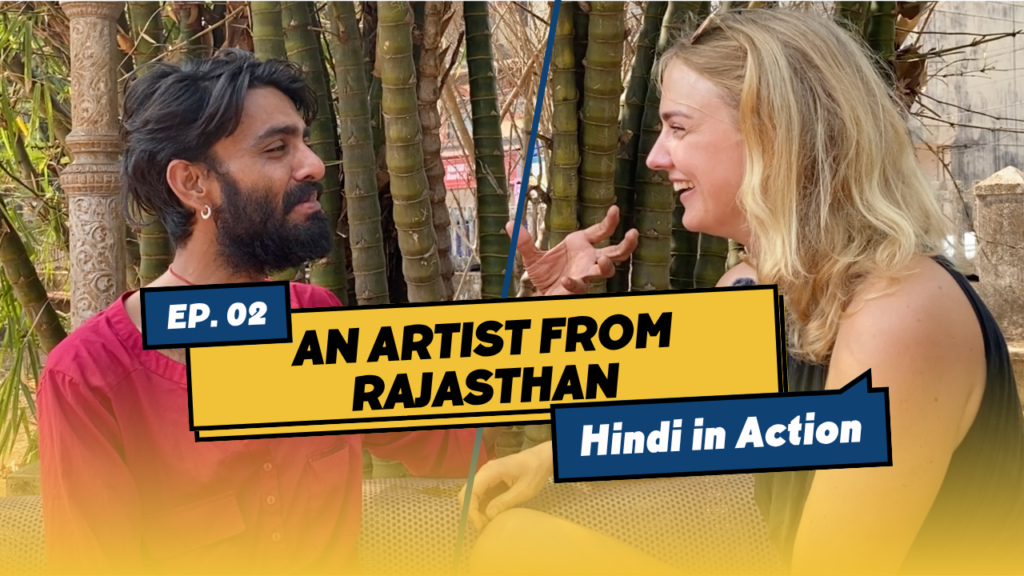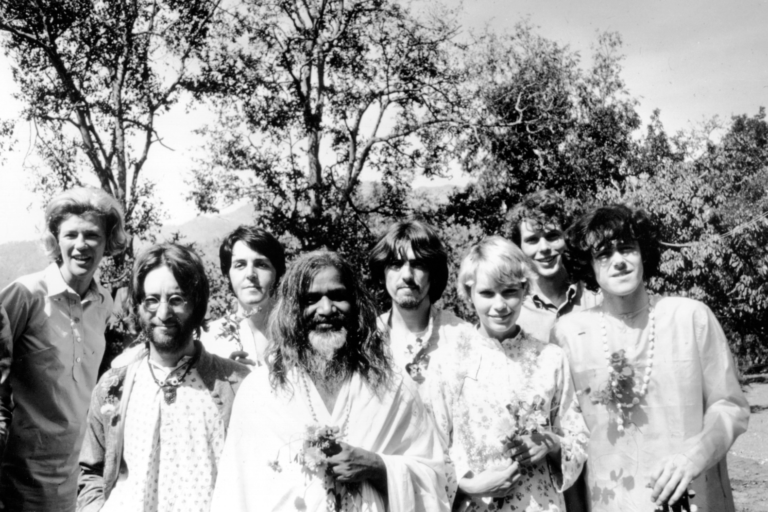How to use ‘jo’ in Hindi — the small word that can deeply improve your clarity. In this post, we’ll show you how to understand and practice the Hindi relative pronoun “जो”, naturally and meaningfully.
A Real Moment From a Learner
This lesson grew out of a real-life moment. Anna, an enthusiastic Hindi learner, offered to help with our Hindi in Action project. Before recording a conversation with Raj, a native speaker, she had a Hindi-only call with me. I was assessing her level and helping her feel comfortable. During our chat, I noticed something very common: when she wanted to say “which” or “who” (a perfect place for “जो”), she instead used “कि”, which is incorrect in this context.
It was a small but telling mistake — one that even intermediate learners make. That’s when we decided: let’s build a conversation around it.
Real Conversation Practice With “जो”
In the interview, Anna spoke with Raaj, a native Hindi speaker from Rajasthan, in a relaxed and natural setting. She asked flowing, conversational questions using “जो”, like:
Which movie did you watch that you really liked
Which song do you like that you listen to again and again?
Is there a book that you’ve read twice?
- Who in your family is someone who cooks really well?
These are great examples to learn Hindi through conversation, and especially to practice relative pronouns in Hindi.
But Real Learning Takes Time
But here’s the most important part: learning a grammar point doesn’t mean we’ll use it correctly right away. At one point, during the natural flow of conversation with Raj (not the structured questions), Anna again skipped over “जो” — even though she understood the grammar. I’ve highlighted this missing “जो” in yellow in the video subtitles so you can spot it yourself.
Learning Grammar Through Conversation
You don’t need to get everything perfect from day one.
Anna’s journey shows how:
- Trying and making mistakes is part of the process.
- Real input and meaningful practice help you grow — and make it fun.
- Grammar builds slowly — but naturally — through exposure and speaking.
Start Practicing “जो” Today
👉 Watch the full Hindi conversation with subtitles
📄 Download the PDF worksheet with a mini test and practice questions
🎯 Master the use of “जो” — with ChatGPT for practice, and real people for fluency.
What Does "जो" Mean in Hindi?
In English, we use who, that, or which to connect ideas, like:
The friend who lives in Delhi
This is the book that made me cry
The place which felt like home
In Hindi, we use जो for all of these.
It’s a relative pronoun — a small word that connects two parts of the sentence.
And in most cases, जो refers back to something earlier in the sentence — usually वह / वो (that).
So instead of two sentences:
- मैंने एक फ़िल्म देखी। I watched a movie.
- वह फ़िल्म मुझे पसंद आई। That movie I liked.
We combine them like this:
- मैंने वह फ़िल्म देखी जो मुझे पसंद आई।
I watched the movie that I liked.
Why "जो" Is Often Confused with "कि"
A common mistake is to confuse “जो” with “कि”.
Here’s the key difference:
- "कि" means “that” as a conjunction and joins two sentences.
- "जो" means “who/which/that” as a relative pronoun and describes a person or thing in the first part.
Compare:
मुझे लगता है कि वह आएगा।
Mujhe lagtaa hai ki vah aaegaa.
(I think that he will come.)
vs.
मुझे वो कुर्ता चाहिए जो हरा रंग वाला था।
Mujhe vo kurtaa chaahiye jo haraa rang vaalaa thaa.
(I want that kurta that was the green one.)
Anna made this exact mistake when she tried to say “which” in Hindi.
She said “कि” instead of “जो” — a very common mix-up for learners.
But you know what? She kept talking. She didn’t stop or panic.
She just used what her brain gave her in that moment — and that’s something truly admirable.
🌟 This is exactly what we celebrate in our project.
Even without perfect grammar, Anna kept the conversation flowing.
And that’s the most important skill you can build: the courage to speak.
You’ll be understood. You’ll learn.
And over time — as you get more input, more practice, and clearer explanations — your grammar will improve naturally in real speech.
But don’t wait for that to start speaking.
⏰ You need to speak now.
That’s what this series is about: helping you speak right away, and then slowly wrapping the grammar around your courage.
Watch the Real Hindi Conversation
In the video below, you’ll see Anna and Raj talking about books, music, dreams, and childhood memories. The conversation includes real-life, flowing questions like:
आपको कौन-सी चीज़ मिलती है जो आपको बचपन की याद दिलाती है?
What’s something you come across that reminds you of your childhood?
❓ How to Ask Questions Using जो
Now here’s something cool — and very useful.
In our Hindi in Action interview, the learner used जो to ask questions.
💡 In questions, instead of using वह / वो in the first part of the sentence, we use कौन-सा, कौन-सी, or कौन (which / who). And then comes जो.
🟨 Spot the yellow highlight!
Anna asks and answers wonderfully — but there’s a moment during the free conversation (not during the questions!) where Anna misses using “जो.” We’ve marked it in yellow in the subtitles, so you can notice it and understand why it matters.
Practice with Questions Using “जो”
Want to test your understanding?
We’ve prepared a PDF worksheet where you can:
- Fill in the blanks with “जो”
- Reflect on your own experiences using the same question patterns
Here are a few examples to warm you up:
- Highlight and translate
- जो vs कि — Choose the correct word
- Complete the question — add the missing word
- Match the sentence halves
- Finish the sentence (Creative Thinking)
- Answer the questions
Want to Practice “जो” with ChatGPT?
In the section above, you can download a free PDF on “जो” in context, featuring interactive grammar tasks, including Task 5 (Creative Thinking) and Task 6 (Answer the Questions). These are open-ended and perfect for experimenting.
Here are three ways you can use ChatGPT to work through them:
Q&A Mode
Write your answer to a question and ask ChatGPT:
“Is this correct?” or “Can you improve my sentence?”
Example:
Mujhe vah khaanaa pasand hai jo… maama banate hain. Is this correct?
Teaching Mode
Ask ChatGPT to explain a sentence or pattern:
“Why is ‘जो’ used here?” or “Can you explain this sentence?”
Example:
Can you explain the sentence: Yah vahi gaanaa hai jo…
Roleplay Mode: Task 6 Comes to Life with Voice!
Turn Task 6 from the worksheet into a fun, speaking challenge!
Use voice mode on your phone and ask ChatGPT to be your Hindi-speaking friend or curious teacher.
Say this to ChatGPT:
Pretend you’re my Hindi-speaking friend. Ask me questions from Task 6 of the जो worksheet. I’ll answer in full sentences using "जो".
Practice storytelling, real-life reflection, and speaking — all in one. Great for fluency, confidence, and sounding natural in Hindi!
Alternate Roleplay Mode: You Ask the Questions!
For Task 6, try this twist: you become the one asking the questions, and ChatGPT plays the role of your Hindi-speaking friend.
Use voice mode and read the Task 6 prompts aloud to ChatGPT. Then:
- 🎤 Practice your pronunciation
- 👂 Focus on listening comprehension as ChatGPT replies
- 🗣️ Improve your fluency by repeating what you understood
After listening, say:
क्या मैंने ठीक समझा?Then explain what you heard — in your own words using “जो”!
📥 Don’t forget: Download the PDF above before starting. Then come back and try these with ChatGPT!
✨ A Small Grammar Note (For Later)
In this video, we kept it simple: just जो.
But later in your learning, you’ll start noticing related forms like:
जिससे — (the person) with whom (I spoke)
जिनके लिए — (the children) for whom (this gift is)
This happens when जो is used with postpositions (like से, के लिए, में, etc.).
🧠 For example:
वह आदमी जिससे मैंने बात की
The man whom I spoke to.
Don’t worry about this now — we’ll make a separate video to guide you through these forms when you’re ready.
💌 Want to Join This Series?
If you’re learning Hindi and would love to:
have a real Hindi conversation
work on your speaking naturally
be part of a fun, creative video project
We’d love to hear from you!
Progress Takes Time
Remember, you don’t have to get it all perfect at once.
Anna’s journey shows that even passionate learners make natural mistakes — and that’s part of the process. What matters is showing up, noticing, and using what you learn, little by little.
With real conversation, friendly support, and meaningful practice, you’ll start using “जो” fluently.
📺 Want more real Hindi in action?
Subscribe to our YouTube channel for practical lessons, real conversations, and inspiring stories from learners like you.
Let Hindi find you — through people, not just textbooks.





